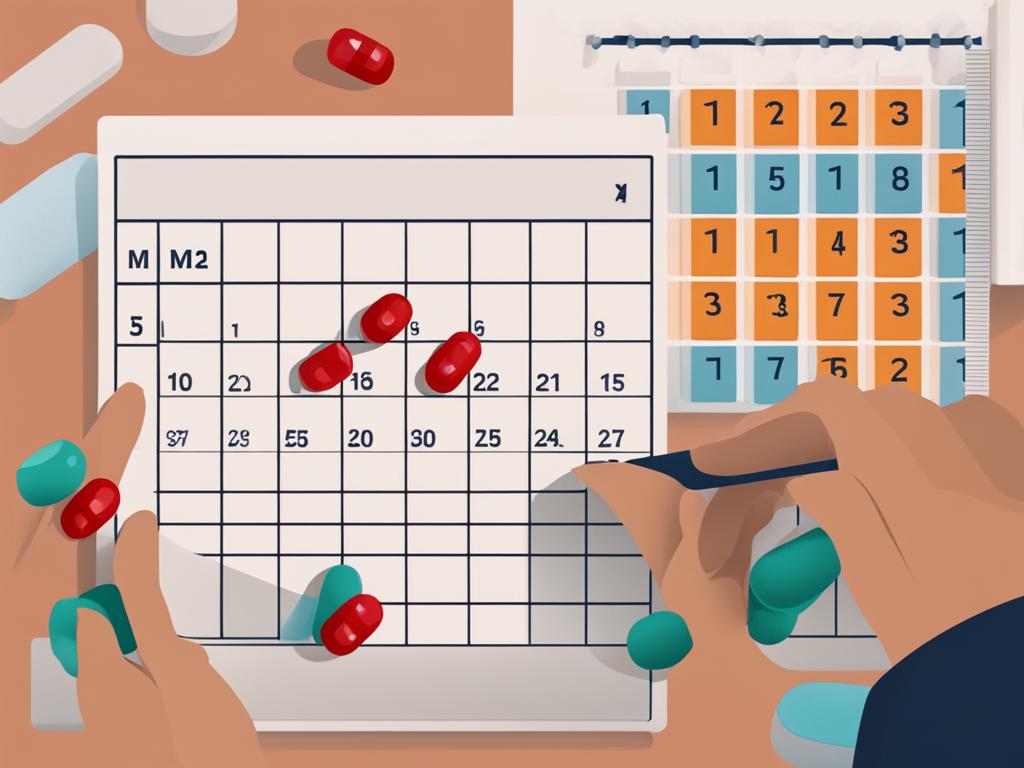Learn How to Reconstitute Semaglutide: A Simple Guide
Semaglutide is a medication used to treat type 2 diabetes and obesity. Reconstituting it is a necessary step for proper administration. In clinical trials, semaglutide has shown significant weight loss results, with participants losing an average of 10% to 16% of their body weight. The U.S. Food & Drug Administration allows for the compounding of semaglutide in case of drug shortages. The process of reconstituting semaglutide involves adding a diluent to the powdered form of the medication and mixing it to form a solution. The specific steps and supplies needed for reconstitution will depend on whether you are using branded semaglutide or compounded semaglutide.
Key Takeaways:
- Reconstituting semaglutide is essential for its proper administration.
- In clinical trials, semaglutide has demonstrated significant weight loss results.
- The compounding of semaglutide is allowed by the FDA in case of drug shortages.
- The process involves adding a diluent to the powdered form of semaglutide and mixing it.
- Supplies and steps may vary depending on whether you are using branded or compounded semaglutide.
Understanding Semaglutide Administration
Semaglutide can be administered using a pen injector, in the case of branded Wegovy, or a small insulin syringe for compounded semaglutide. If your medication comes in powdered form, it will need to be reconstituted before injection. The process involves gathering supplies such as the medication vial, diluent, syringe, and needles. The amount of diluent to be added will be specified in the medication instructions or can be obtained from your pharmacist.
Drawing up the diluent, adding it to the medication vial, and gently mixing the solution are key steps in preparing semaglutide for injection. It is important to follow storage instructions for the reconstituted medication, as some require refrigeration while others can be stored at room temperature. Semaglutide dosing typically follows a gradually increasing schedule to minimize gastrointestinal side effects.
As with any medication, it is crucial to follow the instructions provided by your healthcare provider or pharmacist for proper semaglutide administration. This ensures accurate dosing and reduces the risk of complications. If you have any questions or concerns about the administration process, do not hesitate to reach out to your healthcare professional for guidance.
Table: Supplies for Semaglutide Administration
| Supplies | Description |
|---|---|
| Medication vial | Contains the powdered form of semaglutide |
| Diluent | Liquid used to reconstitute the medication |
| Syringe | Device for drawing up and measuring the medication |
| Needles | Used for injecting the reconstituted medication |
Reconstituting Semaglutide: Step-by-Step Guide
Proper reconstitution of semaglutide is crucial for its effective administration. Here is a step-by-step guide to help you through the process:
Gather Your Supplies
Before starting the reconstitution process, make sure you have all the necessary supplies on hand. These include the medication vial, diluent, syringe and needle, alcohol prep pads, and instructions from your pharmacy.
Clean the Vial and Syringe
Using alcohol prep pads, clean the medication vial and the syringe to ensure a sterile environment for reconstitution.
Draw Up the Diluent
Next, draw up the required amount of diluent into the syringe. The exact amount will be specified in the medication instructions or can be obtained from your pharmacist.
Inject Diluent into the Medication Vial
Inject the diluent from the syringe into the medication vial. Be careful not to touch the tip of the syringe or vial to maintain sterility.
Mix the Solution
Gently roll the vial between your hands to mix the powder with the diluent. Avoid shaking the vial vigorously as it may affect the consistency of the solution.
Store the Reconstituted Medication
After reconstitution, follow the storage instructions provided with the medication. Some forms of semaglutide may need refrigeration, while others can be stored at room temperature. Adhere to the specified storage conditions to ensure the potency and effectiveness of the medication.
Remember, always consult your healthcare provider or pharmacist if you have any questions or concerns about the reconstitution process or the administration of semaglutide.

Table: Supplies for Semaglutide Reconstitution
| Supplies | Description |
|---|---|
| Medication vial | A container holding the powdered form of semaglutide |
| Diluent | A liquid used to reconstitute the medication |
| Syringe and needle | To draw up the diluent and inject it into the medication vial |
| Alcohol prep pads | To clean the vial and syringe for sterile reconstitution |
| Instructions | Provided by your pharmacy for specific reconstitution steps |
Potential Risks and Benefits of Semaglutide
Semaglutide, like any medication, has potential risks and benefits that should be considered when using it for the treatment of type 2 diabetes and obesity. Understanding these risks and benefits can help individuals make informed decisions about their healthcare.
Risks of Semaglutide
It is important to be aware of the potential risks associated with semaglutide. Some individuals may experience side effects such as stomach pain, gallbladder disease symptoms, hypoglycemia, kidney injury signs, or changes in vision. If you experience any of these symptoms, it is important to seek medical attention promptly.
Semaglutide is contraindicated in individuals with a personal or family history of medullary thyroid carcinoma, multiple endocrine neoplasia syndrome type 2, or known hypersensitivity to semaglutide. These contraindications should be considered before starting treatment with semaglutide.
Benefits of Semaglutide
Semaglutide has shown significant benefits in clinical trials, particularly in terms of weight loss. Participants in these trials experienced an average weight loss of 10% to 16% of their starting body weight. This makes semaglutide an effective option for individuals struggling with obesity.
In addition to weight loss, semaglutide can also help manage type 2 diabetes by improving blood sugar control. This can lead to better overall health and a reduced risk of complications associated with diabetes.
Contraindications of Semaglutide
As mentioned earlier, semaglutide is contraindicated in individuals with a personal or family history of medullary thyroid carcinoma, multiple endocrine neoplasia syndrome type 2, or known hypersensitivity to semaglutide. This means that individuals with these conditions should not take semaglutide as it may pose an increased risk to their health.
| Potential Risks | Contraindications |
|---|---|
| Stomach pain | Medullary thyroid carcinoma |
| Gallbladder disease symptoms | Multiple endocrine neoplasia syndrome type 2 |
| Hypoglycemia | Hypersensitivity to semaglutide |
| Kidney injury signs | |
| Changes in vision |
It is important to discuss your medical history and any potential risk factors with your healthcare provider before starting semaglutide. They can provide personalized guidance and help determine if semaglutide is a suitable option for you.
Dosage Schedule for Semaglutide
Semaglutide has a specific dosage schedule that involves gradually increasing the dose over several weeks to minimize gastrointestinal side effects. The maximum dose of semaglutide is 2.4 mg per week. The dosing schedule varies but typically starts with a lower dose of 0.25 mg for the first few weeks and gradually increases to the maximum dose. It is important to follow your healthcare provider’s instructions and track your dosage on a calendar. Before injecting semaglutide, always check the clarity and color of the medication, verify the expiration date, and confirm the prescribed dose.

Following a consistent dosage schedule is crucial for the effectiveness of semaglutide treatment. The gradual increase in dosage helps your body adjust to the medication and minimize digestive system discomfort. It is important to adhere to the prescribed dose and not exceed the maximum recommended amount of 2.4 mg per week.
“Following your healthcare provider’s instructions and tracking your dosage on a calendar can help ensure that you are using semaglutide correctly and are benefiting from its therapeutic effects.”
By closely monitoring your semaglutide dosage and following the recommended schedule, you can optimize the medication’s effectiveness and minimize the risk of side effects. If you have any questions or concerns about your dosage schedule, consult your healthcare provider for personalized guidance and support.
Semaglutide Reconstitution: Important Considerations
When reconstituting semaglutide, there are several important considerations to keep in mind. Following these guidelines will ensure accurate dosing and proper administration of the medication. Here are some tips to help you with the process:
- Follow instructions: It is crucial to carefully follow the instructions provided by your healthcare provider or pharmacist. These instructions will outline the specific steps and supplies needed for reconstitution.
- Double-check the amount of diluent: Before reconstituting semaglutide, double-check the amount of diluent required. Accurate dosing is essential for the medication to be effective.
- Store properly: After reconstituting the medication, make sure to store it according to the instructions provided. Some forms of semaglutide may need refrigeration, while others can be stored at room temperature.
- Seek guidance if needed: If you have any questions or concerns about the reconstitution process, don’t hesitate to reach out to your healthcare provider or pharmacist. They can provide guidance and ensure you have a clear understanding of the process.
By following these considerations and tips, you can ensure that you are reconstituting semaglutide correctly and safely.

Semaglutide and Weight Management
Semaglutide has shown significant effectiveness in promoting weight loss in clinical trials. Participants experienced an average weight loss of 10% to 16% of their starting body weight, making it a promising medication for individuals struggling with obesity. Semaglutide is typically prescribed for individuals with a body mass index (BMI) of 30kg/m2 or higher, or those with a BMI of 27kg/m2 or higher and at least one comorbid condition associated with being overweight.
When used in conjunction with lifestyle changes, semaglutide can be an effective tool for managing type 2 diabetes and obesity. It works by mimicking the effects of a hormone called glucagon-like peptide-1 (GLP-1), which helps regulate blood sugar levels and reduces appetite. By reducing appetite and increasing feelings of fullness, semaglutide can aid in calorie restriction and weight loss.
If you are interested in using semaglutide for weight management, it is important to consult with a healthcare professional to determine if it is a suitable option for you. They can provide personalized guidance on the reconstitution and administration of the medication, as well as monitor your progress and adjust the dosage as needed. Weight loss with semaglutide should always be accompanied by a healthy diet, regular physical activity, and lifestyle modifications for long-term success.

Potential Side Effects
- Thyroid C-cell tumors
- Pancreatitis
- Gallbladder disease
- Hypoglycemia
- Kidney injury
- Changes in vision
Contraindications and Warnings for Semaglutide
Semaglutide, like any medication, has specific contraindications and warnings that should be taken into consideration. It is important to be aware of these potential risks and consult with your healthcare provider before starting semaglutide.
Contraindications:
- Personal or family history of medullary thyroid carcinoma
- Multiple endocrine neoplasia syndrome type 2
- Known hypersensitivity to semaglutide
Warnings:
- Thyroid C-cell tumors: Semaglutide has been shown to cause thyroid C-cell tumors in animal studies. It is important to monitor for any signs or symptoms of thyroid tumors, such as a lump in the neck, and seek medical attention if necessary.
- Pancreatitis: There have been reports of pancreatitis in individuals taking semaglutide. Symptoms of pancreatitis include severe abdominal pain that may radiate to the back, along with nausea and vomiting. If you experience these symptoms, you should stop taking semaglutide and seek medical attention.
- Gallbladder disease: Semaglutide may increase the risk of gallbladder disease, including gallbladder stones. It is important to be vigilant for any symptoms of gallbladder disease, such as severe abdominal pain, and seek medical attention if necessary.
- Hypoglycemia: Semaglutide can lower blood sugar levels, which may increase the risk of hypoglycemia. If you experience symptoms of low blood sugar, such as dizziness, sweating, or confusion, you should treat it promptly with a fast-acting source of glucose and consult with your healthcare provider.
- Kidney injury: Semaglutide has been associated with acute kidney injury in some individuals. It is important to monitor kidney function regularly when taking semaglutide, especially in those with pre-existing kidney disease or risk factors for kidney injury.
- Diabetic retinopathy: Semaglutide may exacerbate diabetic retinopathy, a condition that affects the blood vessels in the retina. If you have diabetic retinopathy, it is important to discuss the potential risks and benefits of semaglutide with your healthcare provider.
“It is crucial to discuss your medical history and any potential risk factors with your healthcare provider before starting semaglutide.”
Being aware of these contraindications and warnings can help ensure the safe and effective use of semaglutide. If you have any questions or concerns about the risks associated with semaglutide, it is important to consult with your healthcare provider for personalized guidance.
| Contraindications | Warnings |
|---|---|
|
|

Conclusion
Reconstituting semaglutide is an important step in the administration of this medication. Whether you are using branded semaglutide or compounded semaglutide, the process involves adding a diluent and mixing the solution before injection. It is crucial to follow the specific steps and instructions provided by your healthcare provider or pharmacist to ensure accurate dosing and proper administration.
Semaglutide has shown promising weight loss results in clinical trials, making it an effective tool for managing type 2 diabetes and obesity. When combined with lifestyle changes, semaglutide can be particularly beneficial. If you are considering semaglutide as a treatment option, it is recommended to consult with a healthcare professional to determine if it is suitable for you. They can provide personalized guidance on reconstituting and administering the medication.
Overall, reconstituting semaglutide is a simple process that can have significant benefits for individuals with type 2 diabetes and obesity. By following the correct steps and instructions, you can ensure the proper administration of this medication and potentially achieve positive health outcomes.
FAQ
How do I reconstitute semaglutide?
To reconstitute semaglutide, gather your supplies including the medication vial, diluent, syringe and needle, alcohol prep pads, and instructions from your pharmacy. Clean the vial and syringe with alcohol prep pads. Draw up the diluent into the syringe and inject it into the medication vial. Gently roll the vial to mix the powder with the diluent. Store the reconstituted medication according to the instructions provided.
What supplies do I need to reconstitute semaglutide?
You will need the medication vial, diluent, syringe and needle, alcohol prep pads, and instructions from your pharmacy.
How much diluent should I add to semaglutide?
The amount of diluent to be added will be specified in the medication instructions or can be obtained from your pharmacist.
How should I store the reconstituted semaglutide?
The storage instructions for the reconstituted medication will be provided in the instructions. Some may require refrigeration, while others can be stored at room temperature.
What is the dosing schedule for semaglutide?
Semaglutide dosing typically follows a gradually increasing schedule to minimize gastrointestinal side effects. The specific dosing schedule may vary, but it typically involves increasing the dose over several weeks.
What are the potential risks of using semaglutide?
Semaglutide has potential risks, including thyroid C-cell tumors, pancreatitis, gallbladder disease, hypoglycemia, kidney injury, and diabetic retinopathy. It is important to be aware of these risks and seek medical attention if you experience any symptoms.
Can semaglutide help with weight management?
Semaglutide has shown significant weight loss results in clinical trials, making it an effective medication for individuals struggling with obesity.
Are there any contraindications for semaglutide?
Semaglutide is contraindicated in individuals with a personal or family history of medullary thyroid carcinoma, multiple endocrine neoplasia syndrome type 2, or known hypersensitivity to semaglutide.
Can I take semaglutide if I am pregnant?
Semaglutide should not be taken if you are pregnant or planning to become pregnant. It is important to discuss your medical history and any potential risk factors with your healthcare provider before starting semaglutide.

